From the State Board
Hopefully, the abundant rain has helped your landscape more than it has eroded it, perhaps softening the impact of August heat. It's hard to believe that fall is almost here, but the signs are there. Some of the earliest plants to leaf out, including red buckeye (Aesculus pavia), are already turning color and dropping leaves. Just as our plants transition at this time of year, it's also a good time to think about how GNPS transitioned over the past year to a statewide focus, and to get your feedback about continuing transitions in the new year ahead. We are particularly interested in how you feel about NativeScape and GNPS publications in general. This could be a good time to adopt a new format, like we once had with a quarterly journal that featured more in-depth articles. And at the same time we could replace monthly newsletters with chapter-focused material that is developed locally. Watch for an upcoming message and survey, but feel free to send suggestions, and perhaps become directly involved, by emailing us anytime at nativescape@gnps.org.
GNPS will host a virtual panel discussion organized by members in the North Metro Atlanta chapter interest group, on Sunday, September 20, 2:00 – 3:30 PM. The event Why Natives? will feature local experts who will share information and resources on why and how to use native plants in our home gardens. Learn how you can foster a diverse and balanced food web that supports birds, butterflies and other pollinators. Panel members include:
- Esther Stokes, Landscape Designer; Board Chair, Georgia Audubon Society
- Trecia Neal, Conservation Specialist, Monarchs Across Georgia
- Holly Loscavio, Program Manager/Camp Director, Dunwoody Nature Center
- Katy Ross, Owner, Night Song Native Plant Nursery
- Moderator: Ellen Honeycutt, GNPS Board Chair
Join with Google Meet: meet.google.com/frx-huir-uig. But if you unable to join at that time because of your schedule, or if it reaches capacity, you will be able to watch a video recording later.
Last month, we reminded you of the upcoming Plant of the Year nominations, which will open on October 1. It's worth mentioning again, because this is your chance to nominate a species you think is special. It may be essential to a particular ecology, or particularly versatile and hardy — something that would grow great in a Georgia garden. Only members can submit a nomination, so consider passing this along to a non-member as incentive to join GNPS and nominate their favorite plant.
And as always, if you have questions or would like to reach us about other matters, send email to board@gnps.org.
Top image: White crownbeard (Verbesina virginica), photo by Ellen Honeycutt.
Chapter News: West Georgia
Carol Hight
Even with the coronavirus disrupting our lives, we have managed to get lots of work done on the Azalea Walk Trail. For the last 6 weeks, we have worked every Tuesday morning to plant rescued and donated plants along a dry creek bed where we had previously installed a beautiful new bridge. The entire area around the fence and dry creek bed was covered with Japanese stiltgrass. Several volunteers spend two Tuesdays pulling this out in preparation for planting natives. We have put in Christmas ferns (Polystichum acrostichoides), netted chain ferns (Woodwardia areolata), ebony spleenwort (Asplenium platyneuron), lady ferns (Athyrium filix-femina), maidenhair ferns (Adiantum pedatum), seersucker sedge (Carex plantaginea), downy skullcap (Scutellaria incana), and New York ferns (Thelypteris noveboracensis).
In addition to the plantings, Frank Bennett hacked away at a tree sized privet hedge. Once he had that down, we planted grancy graybeard (Chionanthus virginica) and a bigleaf magnolia (Magnolia macrophylla), with a couple of other trees to be planted when the weather cools. Once the plants were in the ground, we added some logs along the banks to stop erosion. Frank hauled several very large rocks that were placed throughout the beds.
In addition to the area around the bridge, there was concern about an old fenceline that ran along one of the access trails to the new bridge. Two of our volunteers spent a day removing barbed wire from the posts and cutting back some things that would inhibit easy passage to the bridge.
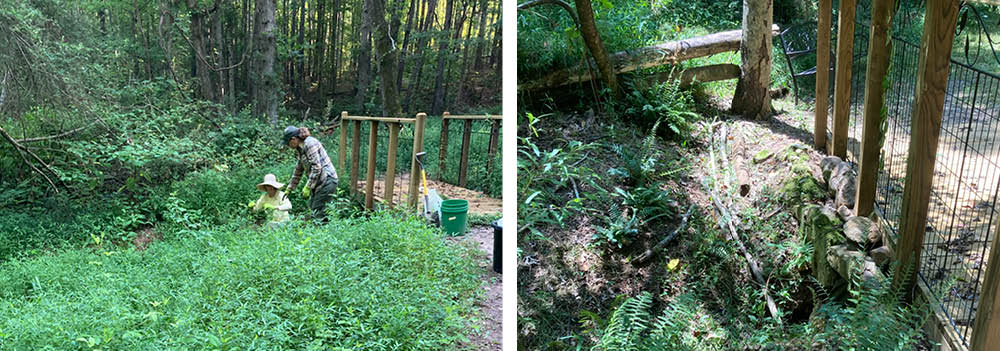
Work continues in the areas adjacent to the new bridge.
We have spent four of our workdays pulling weeds from the pollinator garden and hope that the tree service has delivered us a load or two (or ten like he did last time we asked for only one), so that we can heavily mulch the pollinator garden. If we skip a week, we have to start all over with this rainy weather encouraging the weeds.
Our upcoming plans are to add some more redbud trees to the area where we had planted several a few years ago. Along with the new redbud trees, we will plant some bottlebrush buckeyes (Aesculus parviflora) as understory trees. Rescued Christmas ferns will be added when available to make a nice ground cover under the trees.
We received a grant that will allow us to hire our carpenter to come back and tear down a badly damaged building and to do upgrades to an old Boy Scout camping site to turn it into an outdoor, open-air pavilion. He should start on that sometime within the next two weeks.
On August 21st, we hosted a pollinator census event at the pollinator garden, with 5 people counting pollinators on plants there.
Mark September 19th on your calendar. We are hosting an outdoor plant sale in the open air stalls at the Carrollton Ag Center from 9:00 to 12:00. There will be monitors at the entrance to manage the number of people in the building. We have two or three nurseries coming, as well as having our own plants for sale. Joel Johnston will be bringing his metal art to sell. We welcome all of you to come. This is our first plant sale that is a standalone sale. We usually have a fall sale in conjunction with our fall workshop. If it is a success, it will become an annual event.
Plant Spotlight: Elephantopus
Ellen Honeycutt
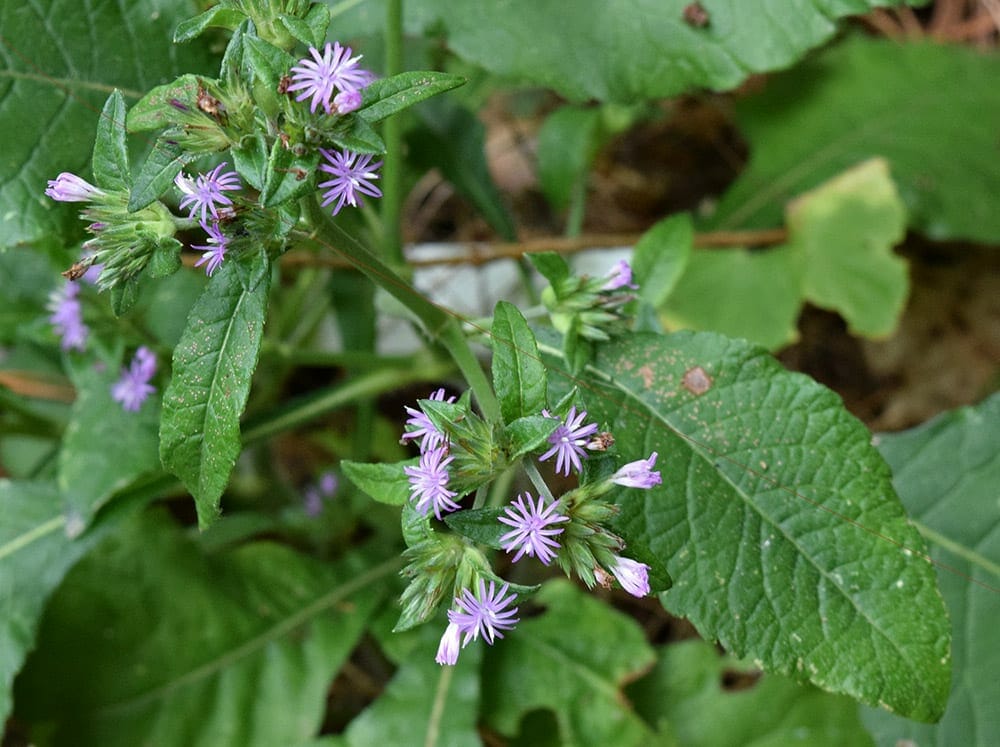
Leafy elephant's foot (Elephantopus carolinianus).
I have found that Elephantopus is a plant that takes people by surprise. Before it blooms, the coarse foliage of this native perennial is often overlooked or dismissed as unattractive. Once the delicate pink-purple flowers open in late summer, folks are surprised first that it’s blooming. Then they’re surprised at how much they like it. And how much bees use it. And that the deer didn’t eat it. They might also be surprised to know these tiny flowers are in the Asteraceae family.
Known as elephant’s foot, there are four species of Elephantopus in Georgia. Two are fairly common: woolly elephant’s foot, Elephantopus tomentosus—which has leaves flat on the ground and nearly leafless stems—and the leafy Carolina species, Elephantopus carolinianus. Smooth elephant’s foot (Elephantopus nudatus) is a Coastal Plain species, as is tall elephant’s foot (Elephantopus elatus)—with the exception of one northern county reported.
Among the species, the plant might be 18 inches to 3 feet tall. If browsed (or cut down) early, it can recover and bloom even shorter (I have several 6-inch ones in my lawn). The flowers can vary from almost white to deep purple but their form is unmistakable. Now is a good time to spot these modest blooms in part-sun to part-shade conditions.
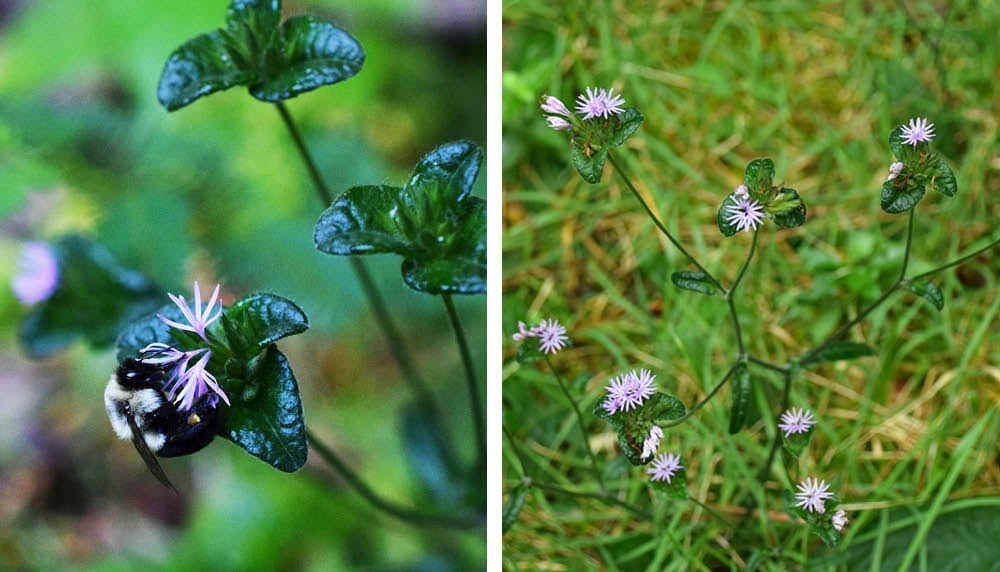
Elephantopus tomentosus.
Logging and Conservation
Heather Brasell
Recent logging operations on my property got me thinking of past comments I’ve heard from native plant enthusiasts that logging creates ugly landscape, destroys wildlife habitats, ruins water quality, and should be prevented at all costs. Many people incorrectly assume that clearcutting is just the prelude to conversion to agriculture or urban development. Logging does impact aesthetics, wildlife habitats, and water quality, but effects may be overestimated and are often short-lived. Unfortunately, some logging operations are environmentally bad news, usually where loggers and/or landowners either don’t know or don’t care. However, bad examples are far from the norm.
So, I’d like to present the viewpoint of a native-plant-loving conservationist who also produces timber. I’ll restrict my comments to operations in sustainably managed southern pine plantations, not mixed pine/hardwood stands in wetland areas, and not critical habitat with endangered species. Although logging does occur in hardwood forests, the practices and the issues are much more complex and problematic.
There are two different kinds of logging operations in planted pine stands: thinning and clearcutting. Typically, a rotation for planted pines is anywhere from 25 years (fiber production) to 35 years (sawtimber production) with up to three thinning operations before the final clearcut.
Consider economic issues. Income from logging is critical to long-term sustainability of forested woodlands. Only 9% of Georgia’s timberland is publicly owned. Some (35%) is owned by corporations and the forest industry. However, most (55%) of Georgia’s timberland is owned by private individuals, who often have multiple goals including conservation, recreation, and family heritage as well as income. These landowners need Income so they can pay property taxes and maintain the forests through good stewardship practices like prescribed burning and controlling invasive species. Income from timber encourages them to conserve forested land rather than convert it to other, often more lucrative, uses that would result in permanent loss of native flora and fauna. For much of the timberland, owners would make a lot more money if they converted the land use to agriculture or urban development. If they could not get some income from timber, far more of the land would be converted to other uses. With sustainable logging, forests are regenerated, not destroyed.
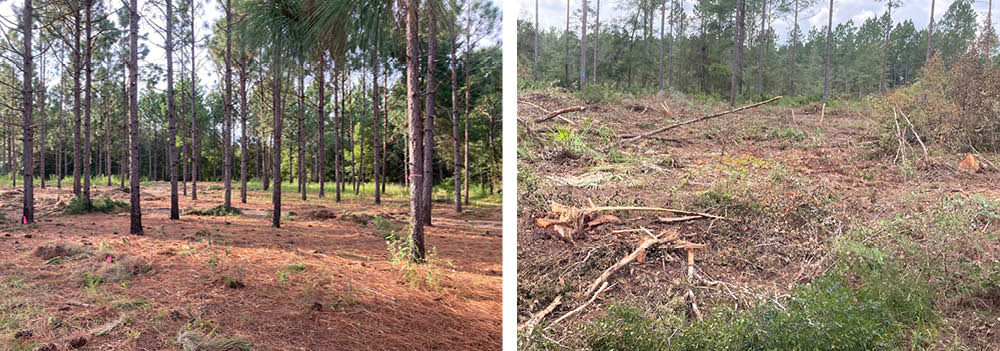 Left: This stand of 19-year-old longleaf pine has just had its first thinning. Right: A clearcut area.
Left: This stand of 19-year-old longleaf pine has just had its first thinning. Right: A clearcut area.
In a thinning operation, the understory is not totally destroyed. In about one of every five rows (the “take-out row”), all of the trees are removed to allow access for the equipment. In between the take-out rows, individual trees are cut and carried to the nearest take-out row by a feller-buncher machine. The understory is just compressed, battered, and bruised. Each bunch of trees is then dragged by a skidder down the take-out row to the loading deck. Dragging severely damages or demolishes the understory in the take-out rows, but it doesn’t take long for the bare soil to be colonized from seeds still in the soil and seeding in from the adjacent undisturbed understory.
In terms of aesthetics, people are more often concerned about clearcuts than thinning operations. When I used to cut his hair, my husband would say that the difference between a good haircut and a bad one was two weeks. It takes a bit longer for a cutover site to look attractive, but it does recover. A lot of our negative impressions derive from what we see driving down the highways, but this is misleading. Highways are constructed to follow well-drained sites as much as possible, so you see a disproportionate amount of cropland and planted pines. On my property, planted pine stands account for only about 50% of the total area, but over 90% of the highway frontage. Many rivers, drains and swamps dissect the Coastal Plain, but you don’t see them from the highway. Just look at an aerial photo to see the cropfields, orchards, and plantation like beads on each highway necklace.
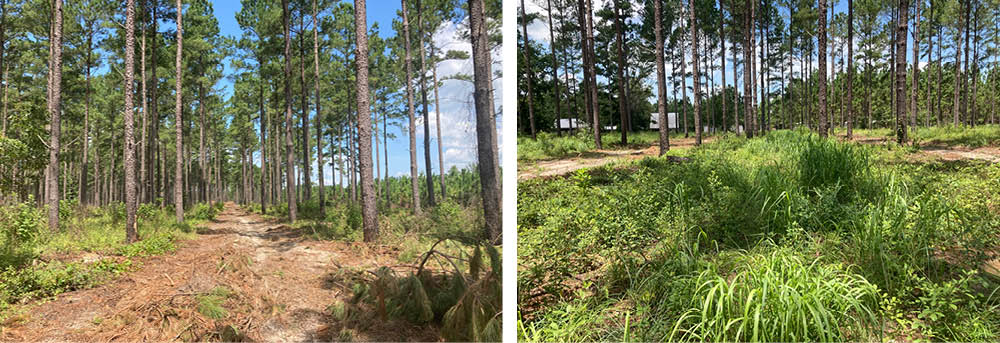 Impact of logging on understory in take-out rows and in-between rows.
Impact of logging on understory in take-out rows and in-between rows.
All clearcuts are not the same. Clearcutting in wetlands and along streams is prohibited by federal law. Clearcutting for urban development, crops, or pasture results in permanent loss of habitat. Clearcutting (or selective harvesting) in old-growth forests results in severe loss of critical habitat, ecosystem diversity, and environmental integrity. However, clearcutting in appropriate settings followed by replanting is just part of sustainable forestry. In plantations, pine trees are an agricultural crop; they just have a much longer rotation than cotton or soybeans. When we concentrate timber production on areas with planted pines, we effectively reduce pressure to extract timber from old-growth or mixed-species forests.
Most timberland in Georgia is managed for sustainable production; every time a forest stand is clearcut, it is replanted. Timberland properties are certified for sustainable practices through programs such as American Tree Farm System (individual landowners), Sustainable Forestry Initiative (industrial landowners), and others. You may see their logos on wood products such as envelopes and packaging. There are economic incentives for sawmills to get as much timber as possible from certified timberland so they can use these logos to target conservation-minded customers.
There are a lot of carrots and sticks to mitigate the adverse impacts from logging and to promote good forest stewardship practices. Carrots include economic incentives, technical support, and training. The invaluable Farm Bill provides cost sharing under Environmental Quality Incentives Program to promote practices (like prescribed burning and control of invasive plants) that cost money but otherwise have no financial return. Organizations such as Georgia Forestry Commission provide technical information, advice, and individualized Forest Stewardship Plans for landowners. In addition, several government and private agencies provide training in good stewardship practices for all forestry stakeholders. These courses, field days, and educational programs provide required continuing education credits for loggers and foresters.
Logging operations follow Best Management Practices (BMP) to help protect soil and water quality. When soils get too wet, the loggers quit logging to prevent excessive soil compaction. In poorly-drained flatwoods, they use special “swamp-logging” equipment and methods. A streamside management zone (SMZ) is left along streams as a buffer to maintain water quality. The width of the SMZ varies depending on slope, type of stream, and presence of trout species. For gentle slopes, the SMZ is 40’ for permanent streams and 20’ for intermittent streams. BMPs also include guidelines for culverts and roads to reduce erosion and minimize impacts on animal habitats and movement. In Georgia, loggers have a very good record for complying with BMPs.
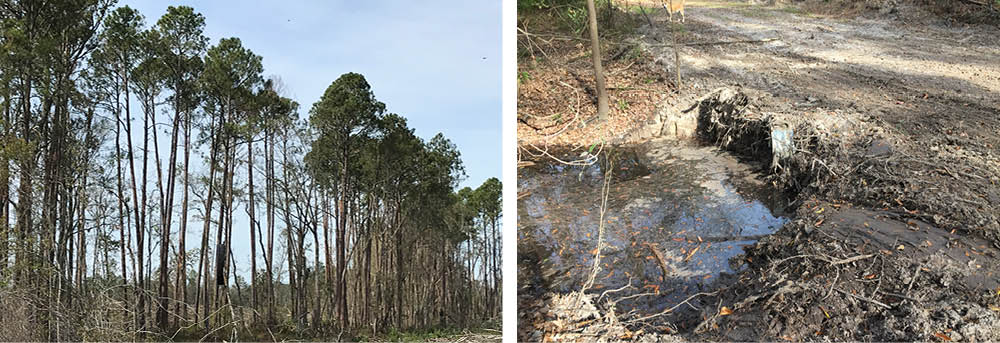 Trees left should (but don’t in this photo) provide a streamside management zone buffer of 20’ on each side of this intermittent stream. Culvert pipes should be low enough they don’t block the natural flow of water and movement of fish and amphibians.
Trees left should (but don’t in this photo) provide a streamside management zone buffer of 20’ on each side of this intermittent stream. Culvert pipes should be low enough they don’t block the natural flow of water and movement of fish and amphibians.
In summary, sustainable forestry, particularly combined with good stewardship practices, promotes plant and ecosystem conservation. In the next issue of NativeScape, I’ll write about the impact of logging on wildlife habitats.
|